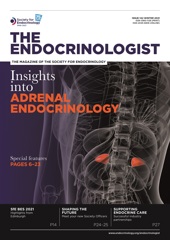Over the last two decades, the peptide growth differentiation factor 15 (GDF15) has been associated with a wide variety of disease states. Although an elevation in circulating GDF15 was clearly a marker of poorer prognosis and disease severity, there remained much uncertainty around the mechanism and true pathophysiological role.
The identification in 2017 of its cognate receptor, GFRAL, in discrete areas of the brainstem, catapulted this hormone back into the limelight. It is a stress-regulated hormone with a potent effect on appetite, body weight and sickness behaviour, so reagents that influence the GDF15–GFRAL axis have real potential to enter the clinical arena.
Our current understanding of the biology of GDF15 comes to us after a long period of iterative groundwork, where a gradual accrual of evidence quietly enabled the great leap forward. In the late 1990s, Sam Breit’s group first identified a peptide termed ‘macrophage inhibitory cytokine-1’ in a cellular model of macrophage activation. Through undertaking related work, several other groups isolated the same molecule as being a member of the transforming growth factor-β superfamily, with a variety of names applied, until GDF15 was more universally adopted.
A MARKER OF CELLULAR STRESS
GDF15 is expressed at relatively low levels in the basal state in most tissues in the body. It is synthesised as a larger propeptide, which goes on to be processed into the bioactive homodimer found in the circulation. In healthy individuals, circulating levels run somewhere between 200 and 1,200pg/ml; they increase with chronological age.
The consensus from both human and murine model studies is that, in the face of a balanced diet, GDF15 does not appear to have a role in day-to-day metabolic regulation. In contrast, whenever tissues are injured or under duress, GDF15 expression and production are markedly upregulated. This stress can come from diverse angles, from intense exercise and altitude-associated hypoxia through to an amino acid-imbalanced diet and environmental toxins. One other fascinating scenario is that of pregnancy. GDF15 is highly expressed in the placenta and, even in normal pregnancy, maternal circulating levels rise rapidly during the first trimester and remain elevated until delivery.
GDF15 AND DISEASE
Elevated circulating GDF15 levels are recognised in a wide variety of disease states, including a number of cancers, heart failure and renal disease. In acute critical illness, levels can exceed 20,000pg/ml. Some of the highest concentrations recorded in any human disease (over 60,000pg/ml) were seen in patients with thalassaemia.
Initial studies in transgenic murine models repeatedly demonstrated that GDF15 was able to reduce food intake and bring about body weight loss. They showed that this was, as is so often the case with blood-borne mediators, probably through regulatory centres in brain. These earlier suspicions were proven to be correct in 2017, when a cluster of reports showed convincingly that GDF15’s robust and dose-dependent ability to reduce food intake came about through action at the GFRAL receptor specifically expressed in the discrete ‘chemoreceptor trigger zone’ areas of the brainstem.
APPETITE AND SICKNESS BEHAVIOUR
Now that the pathway was clear, a slightly revised view of GDF15’s function emerged that still encompassed the irrefutable signals arising from the study of human populations with disease.
GDF15 could now be seen to be rather more than a biomarker. It was recognised as a key player in the allostatic response to illness. The stereotypical response seen in illness is typically one of lost appetite and food aversion that feels quite different from comfortable satiety. Again, animal studies proved highly informative in defining a role for GDF15 in these features of sickness behaviour. Indeed, there is also emerging evidence that GDF15 may play a role in the highly debilitating syndrome of hyperemesis gravidarum seen in some pregnancies.
Furthermore, although an acute rise in glucocorticoid in the face of severe somatic stress is well known to us all, work from our lab has shown that GDF15 can potently and rapidly activate the hypothalamic-pituitary-adrenal axis in rodents, highlighting this as an endocrine circuit in the ‘chemical defensome’ necessary to defend against toxin stress.
CLINICAL APPLICATIONS
Circulating GDF15 is also increased by metformin. Our work, and that of others, has shown the effects of metformin on body weight in animals on a high fat diet to be mediated through a metformin-induced rise in GDF15. We have also identified the gastrointestinal tract as a major site of metformin-induced GDF15 expression.
Anorectic agents based on other gut-derived anorexigens like glucagon-like peptide-1 are now in routine practice, so could a similar picture play out for GDF15 analogues in the treatment of obesity? While there are certainly such agents under active study that show great promise in reducing food intake, it is perhaps too early to know if they can progress to the therapeutic sweet spot of efficacy, safety and tolerability.
At the other end of the spectrum, blocking GDF15 action in conditions where anorexia and weight loss are problematic also makes sense. In the arena of cancer medicine, the use of the widely utilised, platinum-based cytotoxic agent cisplatin can be limited by its side effects, such as anorexia and emesis. Importantly, cisplatin elicits a strong rise in GDF15. In some exciting preclinical studies, antibody-directed neutralisation of GDF15’s action is able to reduce emesis, increase food intake and prevent cisplatin-induced weight loss, suggesting GDF15 neutralisation may be a good additive step in chemotherapy treatment regimens.
CONCLUSION
So, can we perhaps think of GDF15 not so much as one of the housekeepers, but more as a loyal watchman, primed and ready to signal danger and attack from wherever it may arise? Anthropomorphising hormones may be too trivial, but what is clear is that studies of this fascinating hormone have led to clinically relevant insights into serious problems, and it looks like there is much more to come.
TONY COLL
MRC Metabolic Diseases Unit, University of Cambridge Metabolic Research Laboratories, Wellcome Trust–MRC Institute of Metabolic Science, Cambridge
ACKNOWLEDGEMENTS
Thanks to many colleagues in the IMS for thoughtful discussion. Tony Coll is supported by the Medical Research Council (MRC Metabolic Diseases Unit MC_UU_00014/1).
FURTHER READING
Lockhart SM et al. 2020 Endocrine Reviews 41 610–642.
Tsai VWW et al. 2018 Cell Metabolism 28 353–368.
Wang D et al. 2021 Nature Reviews Endocrinology 17 592–607.






